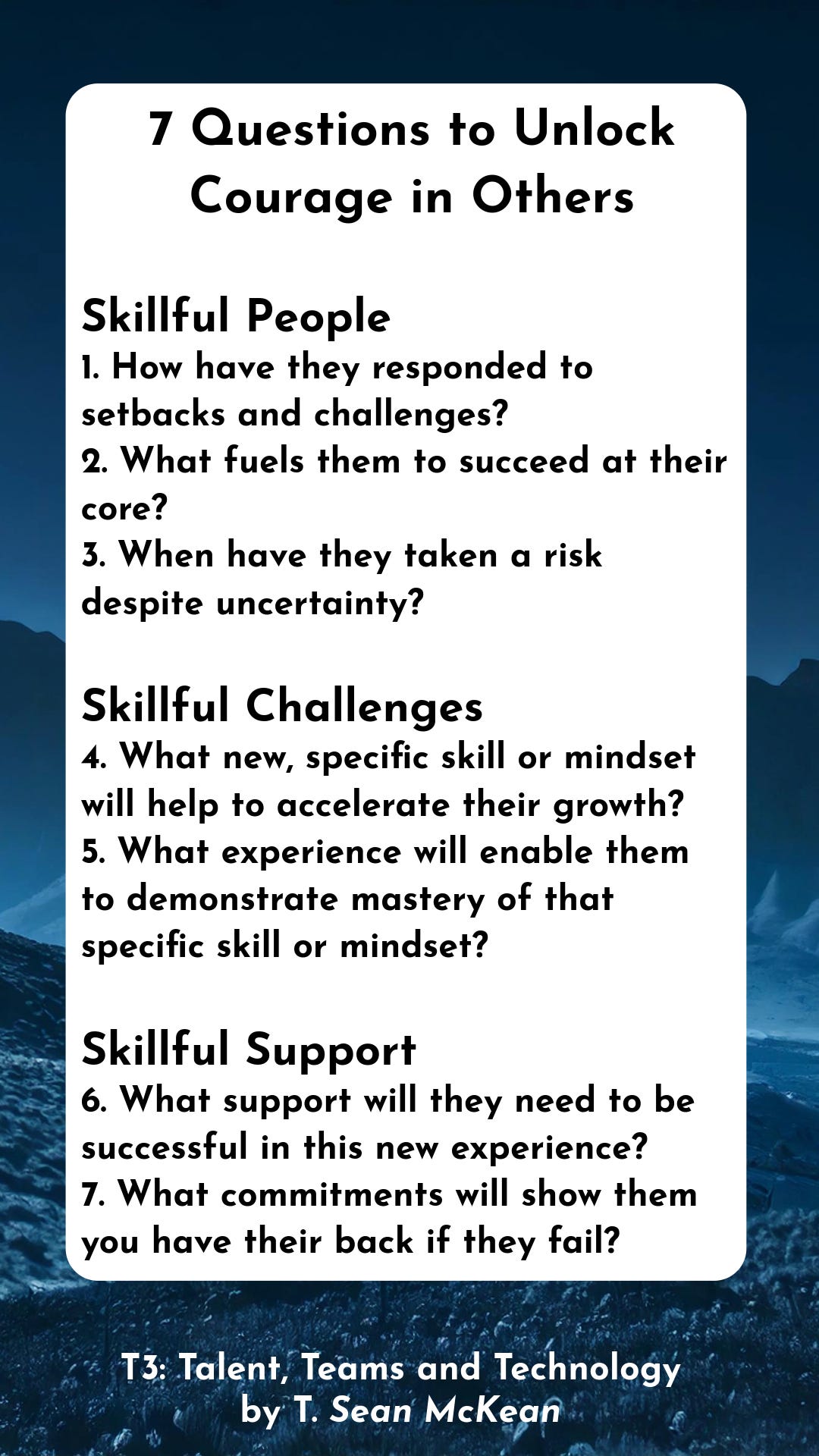Imagine being recruited as a teenager for a bitter and intense battle alongside the world’s most powerful heroes, before you’ve even finished your homework. That’s exactly what happens in Captain America: Civil War when Tony Stark (Ironman) enlists a young Peter Parker (Spiderman) for an all-out clash against fellow Avengers.
It’s a hilarious and inspiring moment.1 Tony Stark sees potential in a young Peter Parker and decides to bring him into an arena far beyond anything Peter has experienced before.
And regardless of whether you’re in camp Ironman, camp Captain America or camp IDGAC, this storyline beautifully illustrates a lesson I’ve seen in spheres ranging from sports to politics to arts to corporate America - great leaders unlock the next level of courage in others, beyond their baseline.
Leadership principle: Unlocking courage is about revealing and activating untapped potential. To do so, focus on skillful people, skillful challenges and skillful support.
Skillful People
A surefire way to get maximum return on effort is to invest your leadership capital in someone with the skill and will to succeed at the next level. The skills you need are context dependent (i.e., experience level, the role, the company, the department). When it comes to will, you are looking for a strong drive to succeed in the face of setbacks, impact-oriented motivation and at least a threshold level of balanced risk-taking. What’s surprising is that I repeatedly see even some of the most seasoned leaders misplace their effort in others that lack these attributes. Imagine if instead of selecting Spiderman, Ironman brought “Arm Fall Off Boy” to the Avengers Civil War.2
To ensure you invest in skillful people, ask yourself these three questions:
Q1: How have they responded to setbacks and challenges? What specific evidence do you have that they push through obstacles with determination?
Q2: What fuels them to succeed at their core: personal ambition, recognition, a need to please others, a drive for impact3 or something else? What are specific examples of how they channeled that motivation into action?
Q3: When have they taken a meaningful risk despite uncertainty? What was at stake, how did they handle it, and what does that reveal about their baseline level of courage?
Remember it’s essential to invest selectively. If any of these three questions cause you to feel some hesitancy, then this person is not a candidate for your primary investment and there is no need to ask the next four questions.
Skillful Challenges
To unlock courage, the opportunities you provide need to align with each person’s confidence and capabilities. Too much too soon can lead to flaming out, while too little can stunt growth. At the same time, aside from helping them grow in their courage, a skillful challenge should also help them deliberately grow a new skill or mindset that is needed for the future. This reflects my belief that tapping into and expanding one’s potential is an essential component of unlocking courage.
To ensure you place them in a skillful challenge, ask yourself these two questions:
Q4: What new, specific skill or mindset will help to accelerate their growth?
Q5: What new role or experience will enable them to demonstrate mastery of that specific skill or mindset?
Skillful Support
“Sink or swim” mentality is mostly an overplayed cliche in organizational life. Many of those who have “made it” to the top often re-write history saying things like “well I did it on my own, why can’t the next generation.” This is garbage. As a leader, you’re responsible for ensuring those you invest in have the support to succeed. Tony Stark knew this and so he got Spiderman an upgraded suit, equipping him for the battle.
Child development research shows that children build skills beyond their current abilities by tackling more complex challenges with the support of adults and guidance from peers. Adults learn in much the same way. To grow, they need opportunities that stretch them (“skillful challenges”), along with the reassurance that they have support if they stumble. When they know you have their back, they see mistakes not as failures, but as stepping stones to growth, reinforcing your investment in their long-term success.
To ensure you provide skillful support, ask yourself these two questions:
Q6: What support will they need to be successful in this new experience?
Q7: What commitments will show them you have their back if they fail? What might get in the way of you actually living up to these commitments?
Take Action: Proven and Practical Steps
Identify the “Skillful People” whose courage you want to unlock. Use the three “Skillful People” questions to figure out who these people are. Make sure you also take the time to identify what context-specific skills are needed for your organization. Lastly, avoid sentimentality in answering these three questions…it will only hurt you later.
Match them to a “Skillful Challenge.” Select a project, role, or experience that fosters a critical skill or mindset they need to grow into future leadership roles. Be explicit with them that this new opportunity will stretch them in this area (e.g., long-term thinking, negotiation, leading change).
Make your “Skillful Support” visible and tangible. Provide structured feedback, mentorship, and access to resources (training, coaching, connections to others).4 Clearly communicate that failure is a learning opportunity, not a career setback. More importantly, show them that you mean this. Have their back in front of other colleagues and take ownership of their setbacks (don’t blame them or critique them). Also, consistently remind others that the purpose of their new role or experience is to help them develop in a new dimension - it won’t be smooth sailing from the get-go.
Reflect: Some Questions to Consider
Are you investing in skillful people?
What are specific roles or new experiences that you can create to unlock courage in others?
Do the people you are investing in know that you have their back? If so, how do they know? If not, what do you need to do differently?
If this week’s Friday Reflection was practical or enjoyable (or maybe even both!), please share it with your colleagues and friends.
So many good gems from this scene including this back and forth:
Tony: “You’re Spider-boy?”
Peter: “Spider…man.”
Tony: “Not in that onesie, you’re not.”
Yes - Arm Fall Off Boy is a real super hero in DC Comics. His superpower…taking his arm off and using it as a weapon. I give them an A+ for the “literalness” of his name.
This one can be hard to define, so consider this definition as a starting point: A drive for impact is characterized by a deep motivation to create meaningful change, contribute to a larger purpose, or make a tangible difference beyond personal success. People with a drive for impact focus on outcomes that benefit their team, organization, or society, rather than just personal advancement. They are energized by solving important problems, improving systems, or leaving a lasting positive mark on their work and the people around them.
And for what it’s worth, at one point in the scene I mentioned above, there is a great illustration of what “drive for impact” sounds like. Tony asks “Why are you doing this?…What gets you out of that twin bed in the morning?” And Peter’s response is “when you can do the things that I can, but you don’t and then the bad things happen, they happen because of you.” And then Tony paraphrases, so “you just want to look out for the little guy…do your part…make the world a better place and all that.”




